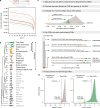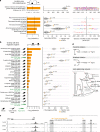Phenotype loss is associated with widespread divergence of the gene regulatory landscape in evolution
- PMID: 30413698
- PMCID: PMC6226452
- DOI: 10.1038/s41467-018-07122-z
Phenotype loss is associated with widespread divergence of the gene regulatory landscape in evolution
Abstract
Detecting the genomic changes underlying phenotypic changes between species is a main goal of evolutionary biology and genomics. Evolutionary theory predicts that changes in cis-regulatory elements are important for morphological changes. We combined genome sequencing, functional genomics and genome-wide comparative analyses to investigate regulatory elements in lineages that lost morphological traits. We first show that limb loss in snakes is associated with widespread divergence of limb regulatory elements. We next show that eye degeneration in subterranean mammals is associated with widespread divergence of eye regulatory elements. In both cases, sequence divergence results in an extensive loss of transcription factor binding sites. Importantly, diverged regulatory elements are associated with genes required for normal limb patterning or normal eye development and function, suggesting that regulatory divergence contributed to the loss of these phenotypes. Together, our results show that genome-wide decay of the phenotype-specific cis-regulatory landscape is a hallmark of lost morphological traits.
Conflict of interest statement
The authors declare no competing interests
Figures




References
Publication types
MeSH terms
Substances
LinkOut - more resources
Full Text Sources

